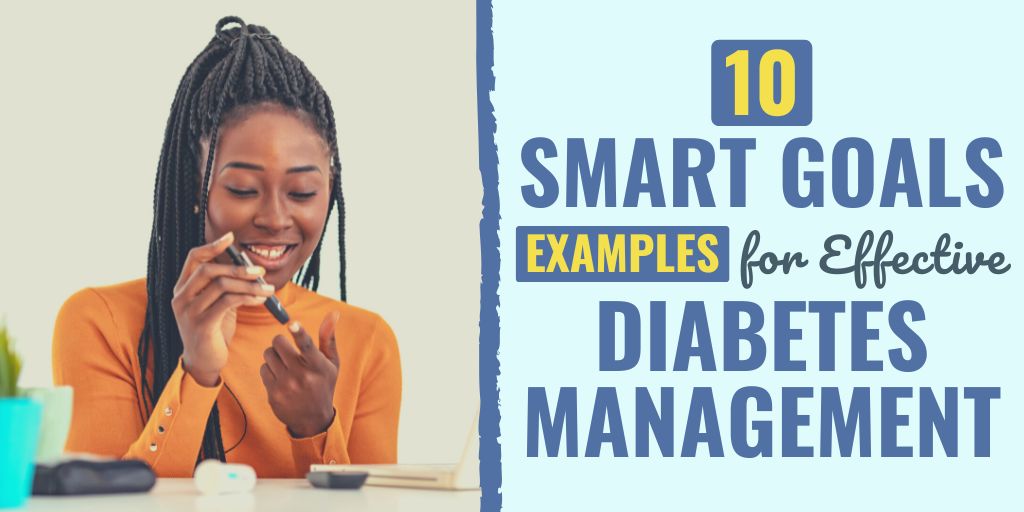There might be affiliate links on this page, which means we get a small commission of anything you buy. As an Amazon Associate we earn from qualifying purchases. Please do your own research before making any online purchase.
Managing diabetes can be difficult. There are many challenges in effective diabetes management, such as keeping track of blood sugar levels, exercising and eating healthy, and getting regular checkups.
However, by setting SMART goals and adhering to them, diabetes management can be easier and more successful. SMART goals allow you to set measurable and achievable goals that will help you keep your diabetes under control.
This article will discuss several examples of SMART goals for diabetes management. We’ll first look at what SMART goals and challenges you may face in diabetes management. We’ll then move on to various examples of these goals.
What Are SMART Goals?
Before we talk about examples of smart goals for diabetes management, it would be beneficial to know what SMART goals are.
SMART stands for Specific, Measurable, Achievable, Relevant, and Timely. Let’s break this down by each letter.
If you want to learn more about SMART goals and what they entail, we recommend checking out this Ultimate Guide to SMART Goals.
Why Are SMART Goals Important for Effective Diabetes Management?
Diabetes is a serious condition that can have life-changing and life-threatening ramifications if not properly managed.
Unfortunately, there are various challenges you will face when you manage your diabetes, such as remembering to monitor and record your blood sugar. Knowing the correct range is crucial to effective diabetes management.
Another challenge is performing physical self-examinations, particularly for your feet. Remembering to check your feet daily, and knowing what to look for, can be difficult.
Diabetes can cause and be affected by stress in your life, and many people have trouble managing it. Moreover, stress can directly lead to high blood pressure, which isn’t beneficial if you have diabetes.
Perhaps two of the biggest challenges will be maintaining a healthy diet and getting enough exercise. Most healthcare practitioners will tell you that one key to effective diabetes management is a healthy diet and exercise.
Even something as simple as having regular medical checkups can be a challenge. This applies to many facets of your health, including your foot, eye, and dental health and your general condition.

One of the best ways to manage these challenges is to create SMART goals. If you set specific, measurable, achievable, relevant, and timely goals, you should be able to overcome them.
Overcoming these hurdles should be doable with clearly defined goals that are possible to attain, a deadline to meet those goals, and ways to measure progress.
SMART goals provide focus, motivation, and direction. Safely managing your diabetes will become second nature if you do these things.
6 SMART Goal Examples for Diabetes Management
We will now look at various SMART goal examples for diabetes management. The aim is to help you overcome the obstacles we discussed in the previous section.
1. Check Blood Sugar Levels
“I will check my blood sugar levels as often as I take insulin. I will remember to do this by setting a reminder for myself on my smartphone. When measuring my blood sugar, I will aim for 4.0 to 7.0 mmol/L when I am fasting and for 5.0 to 10.0 within two hours of eating. If I have low blood sugar, I will need to take the appropriate steps to correct the situation.”
S: This is a specific goal, as you aim to test your blood sugar levels a particular number of times each day and maintain specific blood sugar levels.
M: This goal is measurable, as you can easily track how many times per day you measure blood sugar and what these blood sugar levels are.
A: By setting reminders to check your blood sugar, this goal is easily attainable.
R: This goal is relevant as monitoring blood sugar levels relates directly to effective diabetes management.
T: This goal is time-bound, as you are setting specific times each day to test your blood sugar and aiming to maintain certain blood sugar levels regarding when you ate food.
2. Follow the 15/15 Rule
“If my blood sugar is low, I will follow the 15/15 rule: I will check my blood sugar, and if it is less than 4.0 mmol/L, I will treat it with 15 grams of carbs. I will then wait 15 minutes and retest my blood sugar levels. If the level is still under 4.0 mmol/L, I will treat it with another 15 grams of carbs and wait another 15 minutes. If my blood sugar reaches 4.0 or over, and I am within one hour of a meal, I will have a small snack. After I have tested my blood sugar three times, and it is still under 4.0 mmol/L, I will immediately seek medical assistance.”
S: This goal is specific, as you know precisely when to measure your blood sugar and what to do if the levels are low.
M: This goal is measurable, as you are using precise equipment to measure your blood sugar levels, and you have a clear plan of action if your blood sugar is too low.
A: This goal is easy to achieve because of your clear plan of action.
R: This is a relevant goal, as diabetes management focuses on healthy blood sugar levels.
T: This is a time-based goal because you will wait 15 minutes between checking blood sugar levels.
3. Do 30 Minutes of Moderate Exercise Every Day
“I will aim for at least 30 minutes of moderate physical exercise per day, for at least 150 minutes per week. I will also include various cardiovascular, muscle-building, and bone-building activities. In addition, I will set aside 30 minutes every morning for exercise.”
S: This goal is specific because you aim to perform a specific amount of exercise each day and various activities.
M: This goal is easy to measure because you can easily monitor how much time you spend exercising each day.
A: This goal is easy to achieve because finding 30 minutes per day to exercise should not be too challenging. If you have trouble adhering to a routine, check out this guide on creating and maintaining a solid morning routine.
R: This goal is relevant because exercise is one of the biggest cornerstones of diabetes management.
T: This goal is time-based, as you are aiming for a certain amount of exercise each day.
4. Quit Smoking
“My goal is to use various counseling methods and quit-smoking aids to stop smoking tobacco within the next month. My goal is to reduce my tobacco intake by at least three cigarettes per week. I will seek assistance from my healthcare professional within the next three days to stop using tobacco products.”
S: This goal is specific as the aim is to stop smoking and using tobacco products using particular methods within a specific time frame.
M: This goal is measurable because if you start with 10 cigarettes per day in the first week, and you reduce intake by 3 cigarettes, then you should only be consuming 7 cigarettes per day in week two, etc.
A: This goal is achievable because many aids can help you quit smoking. If you have trouble cutting out tobacco and other bad habits, this guide on developing good habits can help.
R: This goal is relevant because tobacco use is not good if you have diabetes, or in general.
T: This goal is time-based because you are looking to cut down on tobacco by specific amounts within an allotted time.
5. See Doctor Every 3 to 5 Months
“I will see my doctor every three to five months, get a dental checkup once per year, and have a yearly eye exam and a yearly foot exam. I will also follow any healthcare professional team’s advice, specifically my diabetes management goals.”
S: This goal is specific as you aim to visit healthcare professionals within certain periods.
M: This goal is measurable as you can easily track how often you visit these professionals.
A: This goal is attainable, as setting aside enough time for a few yearly appointments should not be too challenging.
R: This goal is relevant because these doctors will provide insight into the current state of your condition and overall health.
T: This goal is time-based, as the aim is to visit certain healthcare professionals at specific intervals.
6. Engage in Guided Meditation
“I will spend at least 15 minutes every day engaging in guided meditation or other relaxation exercises to help me relax and relieve stress.”
S: The specific aim of this goal is to engage in 15 minutes of relaxation exercises to reduce stress.
M: Although this goal is slightly harder to measure, as how much stress you feel is subjective, you can still gauge how stressed and anxious you feel.
A: This goal should be easy to achieve, as setting 15 minutes per day for relaxation should be doable.
R: This goal is relevant because stress management also relates to blood pressure management, which then, in turn, relates to effective diabetes management.
T: This goal is time-bound, as the aim is to engage in 15 minutes of relaxation every day. Your deadline is the end of each day.
7. Take Medication as Prescribed
After getting diabetes prescriptions from my doctor to manage diabetes, I will take them as prescribed. If not, it is nearly impossible for my doctor to accurately assess my health between visits. Which can lead to additional health problems.
I will set daily reminders on my smartphone to take my dosages consistently. When I go to work, I will take any insulin pins and a pill organizer for metformin tablets, so I am equipped to take diabetes medication throughout the day.
S: This goal is specific to managing diabetes, focusing on taking medicines regularly for the best results.
M: The success of this goal can be measured by the fact that medications are being taken as prescribed daily. Therefore, keeping your diabetes in check.
A: There is nothing about this goal that cannot be attained because of the plan that is in place. It conveniently fits into the daily routine.
R: This goal is relevant to managing diabetes because we can relate to times when we have prescribed medicines and forget to take them regularly. So, this goal is a proactive approach to avoid history repeating itself so diabetes can be appropriately managed.
T: By following this process with daily reminders, blood glucose numbers can be managed appropriately, and adjustments can be made if there are other underlying factors hindering the management of diabetes between medical visits.
8. Properly Treat Breaks in the Skin
Breaks in the skin, such as cuts, scrapes, and scratches, can lead to many health problems for diabetics if not correctly treated. Cracks in the skin can lead to infection, elevated blood glucose levels, and other harmful conditions.
Since I know diabetes can slow the healing process, I will keep my hands washed at least 10 times a day and carry hand sanitizer and wipes in my purse and car when I am away from home.
I will demonstrate self-care by moisturizing my skin daily with lotion after handwashing and treat dry, cracked feet daily to avoid cellulitis.
I will also carry bandages to adequately clean and treat a break in the skin if it occurs while I am on the go.
S: This goal is specific to treating your skin with care, knowing that breaks in the skin and uncleanliness can lead to conditions that make it challenging to manage blood sugar.
M: You can measure the success of this goal by noticing how clean and soft your skin is and noticing a reduction in breaks to the skin.
A: This goal includes managing diabetes through proper skin care, which can be attained with cleanliness, moisturizers, and good first aid.
R: Treating dry skin and knowing how easy breaks in the skin can occur when it’s dry is relevant to the goal of managing diabetes. Breaks in the skin lead to infection and other skin conditions.
T: This goal is time-bound because I will wash my hands at least 10 times daily and moisturize them with lotion after each washing. I will also moisturize every day to avoid breaks in the skin, helping to manage diabetes.
9. Get Adequate Sleep
Adequate sleep (over 7 hours) for a person with diabetes is essential to managing it. It helps me not be insulin resistant, controlling my appetite throughout the day. As a result, I can evade higher blood pressure and possible weight gain.
I will avoid drinking caffeine in the late afternoon and evening. It can affect my body for 8 hours or more. I'll keep my bedroom dark and the temperature cool (around 65 degrees) at night. Experts believe that's optimal for the best results when resting.
I will ensure the TV remote, computer, and smartphone aren't within reach when I'm in bed. They can interfere with the quality of my sleep. I will avoid eating meals late at night, affecting my sleep and raising blood sugar levels.
This will result in a steadier appetite, stable weight, and consistent daily blood glucose reading.
S: This goal is specific about the benefits of getting adequate sleep to manage diabetes.
M: The goal can be measured by the quality of your time of rest, which is reflected in your daily appetite, overall weight, and blood glucose numbers when checked daily.
A: The goal here can be attained by following the process laid out for adequate rest, resulting in diabetes being better managed.
R: This goal is relevant because the better the sleep, the better it is for your overall diabetic health.
T: As the goals are met daily to acquire adequate rest, diabetes can be appropriately managed.
10. Stop Consuming Alcohol
Alcoholic beverages can be high in calories and sugar. Plus, alcohol turns into sugar in the body during digestion. So, by deciding to stop consuming alcohol, I can immediately see a change in blood sugar levels because it reduces blood glucose spikes and helps me manage my weight better.
First, I will remove all alcoholic beverages from my home and not consume them when eating out. Then, if I find it a struggle, I will talk to my doctor to see if it is necessary to participate in a medically supervised detox program, which may take 30, 60, or 90 days, depending on the severity of my case.
It is a safe and effective way to cleanse my system of alcohol and get on the road to manage my blood sugar.
S: This goal is specific to how eliminating alcohol usage can help manage diabetes.
M: The goal is measurable because it guides a person to stop drinking alcohol entirely because it doesn't promote diabetic health.
A: This goal is attainable by showing various measures that can be taken to eliminate alcohol from the diet and keep diabetes in check.
R: This goal is relevant by showing how the consumption of alcohol can significantly hinder diabetes management.
T: The time to eliminate alcohol usage and manage diabetes can happen immediately on your own or in 30, 60, or 90 days with medical supervision.
Final Thoughts on Examples of SMART Goals for Diabetes Management
Setting SMART goals for diabetes management is not overly complicated. However, adhering to these goals can sometimes be a challenge.
However, if you set the right goals and adhere to the five letters of the SMART acronym, you should achieve effective diabetes management.
Remember that these SMART goals can also be used for everyday life, not just diabetes management. Set your SMART goals today and get your diabetes under control!
Learn how to turn your Smart Goals into habits by checking out this video:
And if you want more SMART goal ideas and examples, be sure to check out these blog posts:
- 15 SMART Goals for Nutrition (Examples for Your Healthy Eating Plan)
- 13 SMART Fitness Goals Examples That Will Motivate You
- 8 SMART Goals Examples for Weight Loss
Finally, if you want to take your goal-setting efforts to the next level, check out this FREE printable worksheet and a step-by-step process that will help you set effective SMART goals.


